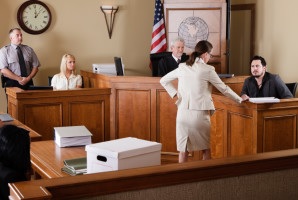Having the right equipment is worthless unless you know how to use it. That is why the second important element to using multimedia at trial is preparation. I never, ever, ever use anything at trial that I have not practiced with. For PowerPoint, this means doing a complete practice run just as if I was at trial. This starts with unpacking and setting up the equipment from scratch. Then I click through each slide to make sure that they are in the correct order, they all work and that they appear big enough for the jury to see them.
PRACTICE TIP: Text slides and bullet points are not recommended. Juries do not like them. Use PowerPoint for images (photos and important documents) and video. The jury should be focused on you, your client and the story you are telling, not looking past me to read text on a screen. I only use text slides in two circumstances: showing jury instructions in conjunction with my argument, and showing the verdict sheet as I believe it should be completed.
 The preparation for using video is basically the same. Actually, it may be even more important. If you have a malfunction in your opening statement, you can always ditch the PowerPoint and go old school, Moe Levine-style. Heck, if handled gracefully it might even help you with the jury by humanizing you and showing you are cool under fire. Good lawyers can tell a compelling story with nothing but their words, eyes, and body language. An expert video is different. You can’t toss it aside if it doesn’t work because then all of your medical evidence is gone. You have a huge hole in your case where the expert testimony on medical treatment and causation should have been. Yeah, I guess you could read the testimony into the record if there was really no other option, but that is just awful. Unpersuasive and irritating.
The preparation for using video is basically the same. Actually, it may be even more important. If you have a malfunction in your opening statement, you can always ditch the PowerPoint and go old school, Moe Levine-style. Heck, if handled gracefully it might even help you with the jury by humanizing you and showing you are cool under fire. Good lawyers can tell a compelling story with nothing but their words, eyes, and body language. An expert video is different. You can’t toss it aside if it doesn’t work because then all of your medical evidence is gone. You have a huge hole in your case where the expert testimony on medical treatment and causation should have been. Yeah, I guess you could read the testimony into the record if there was really no other option, but that is just awful. Unpersuasive and irritating.
 Baltimore Injury Lawyer Blog
Baltimore Injury Lawyer Blog


 The most important part of a personal injury trial is the plaintiff’s testimony. Specifically, the most critical part of a trial is the personal injury plaintiff’s direct examination. If it doesn’t go well when you are in total control of the process and the facts, it will be nearly impossible to get a favorable damages award. We believe in thoroughly preparing the plaintiff to testify, both on direct and cross-examination. I would not be surprised to learn that our firm spends more time on direct examination preparation than any firm in Maryland.
The most important part of a personal injury trial is the plaintiff’s testimony. Specifically, the most critical part of a trial is the personal injury plaintiff’s direct examination. If it doesn’t go well when you are in total control of the process and the facts, it will be nearly impossible to get a favorable damages award. We believe in thoroughly preparing the plaintiff to testify, both on direct and cross-examination. I would not be surprised to learn that our firm spends more time on direct examination preparation than any firm in Maryland. The preparation for using video is basically the same. Actually, it may be even more important. If you have a malfunction in
The preparation for using video is basically the same. Actually, it may be even more important. If you have a malfunction in